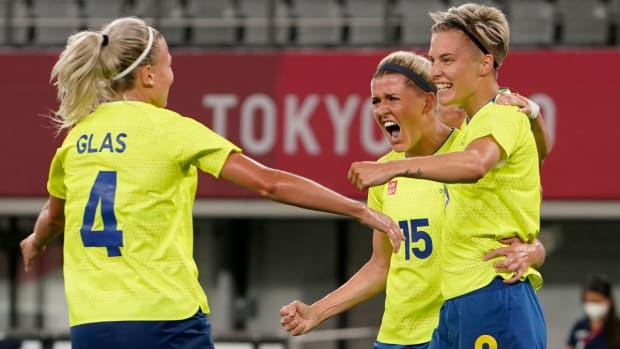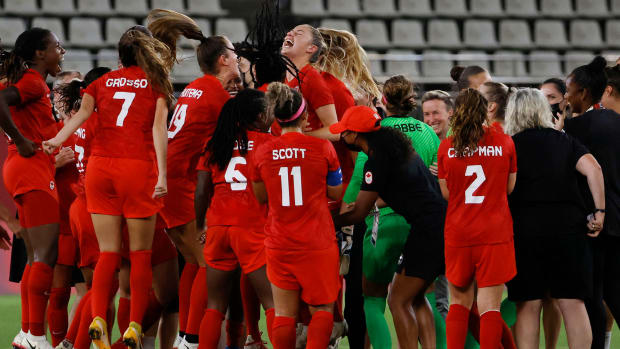It may not be good for the USWNT that it has missed out on another Olympic final, but a more crowded top tier will only push the sport forward in the long run.
TOKYO — When Sweden and Canada meet in the women’s soccer gold medal game, they will make subtle history: For the first time, the two finalists in an Olympics or Women’s World Cup beat the U.S. to get there.
It’s not a fluke, either. The Swedes have been the best team in this tournament; they have played five games and trailed only once, for four minutes. As U.S. fans wonder what happened to their team, the most relevant answer comes from beyond the borders. Sweden happened. Canada happened. Europe happened. The exploding global popularity of the sport happened.
Any discussion at the end of tournament is full of analytical potholes: recency bias, overreaction, predicting the future. The point here is not that Sweden has surpassed the U.S. as the world’s premier women’s soccer power. It’s that the game’s popularity is spreading, more countries are committed to competing, and logically, it is harder for one team to dominate.
This is good for women’s soccer. Heck, it’s good for the world. But it is not so great for people who want to see the U.S. win every single time.
The Olympics are just one tournament. The U.S. won the last major competition, the Women’s World Cup in 2019. But the Olympics are instructive—not for what they say about the USWNT, but for what they say about the likes of Sweden.

Five years ago, when Sweden stunned the U.S. on penalty kicks in Rio, there was a sense that if the teams played 10 more times, the Americans would win at least eight. This year, Sweden would likely be favored to win most. Swedish coach Peter Gerhardsson, who was hired in 2017, said the country’s feeder system has advanced significantly since he took over.
“The play is stronger, and [there are] better clubs,” Gerhardsson said during a press conference at the Olympic Village Thursday evening. “From better clubs, you get a better environment, better teammates. better training—maybe better coaches, I don't know. You have the possibility to get better every day.”
Sweden played the first women’s international match, against Finland in 1973, but by the 1990s, when women’s soccer started to establish itself as a global spectator sport, the U.S. had a significant financial and talent advantage. That gave the Americans a head start, but the lead has shrunk.
When the U.S. sent NBA superstars to the 1992 Olympics, it was both a show of dominance and an attempt to create parity. Three decades later, the U.S. remains the best men’s basketball nation in the world. But it is nowhere near as dominant as it was in '92.

The USWNT was never as dominant as the basketball Dream Team. It also has never had the advantage of an established, wildly popular professional league in the U.S. American fans have supported their national team as well as any fans in the world. Alex Morgan, Megan Rapinoe, Mia Hamm, Abby Wambach and Carli Lloyd are all more famous than anybody on the roster of some Major League Baseball teams, for instance. But support of the National Women’s Soccer League, while on the right trajectory, has been spotty, and while the league has found solid ground as it enjoys its ninth season, its predecessors all met their demise.
Meanwhile, clubs have sprouted all over Europe, either as part of clubs that have famous men’s teams or as independent women’s teams. When the Swedes beat Brazil in the 2003 Women’s World Cup, 1.5 million out of eight million watched on TV. You can imagine what happened next. In 2003 there were roughly 40,000 women registered to play in Sweden; 16 years later, there were almost 95,000.
In 2007 the Netherlands’ federation organized a women’s professional league. That was replaced by a Belgian-Dutch league in 2012 but resumed play in '15. This year, the Dutch took the U.S. to penalty kicks before losing their quarterfinal, two years after reaching the Women's World Cup final against the U.S and wilting in the second half.
There are, quite literally, more where they came from. In the 2019 World Cup, eight of the 16 teams that made it out of the knockout stage were from Europe. But as Gerhardsson pointed out, “In the Olympics there’s just three [in the whole tournament]. That’s the rule.”
This year’s bronze-medal-winning USWNT was a group on the verge of transition, with a number of legends on the way out. It would have been great for the U.S. players and fans if they had won gold, anyway, but it speaks well of the sport that they didn’t. Canada, which had been knocking on the door of the top tier after consecutive bronzes in London and Rio, is very good and found a way to win the semifinal. Sweden has proved to be a better team than America is right now. The U.S. will remain a powerhouse, but it will continue to have company.
More Olympics Coverage: